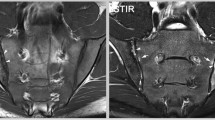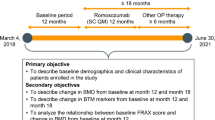Abstract
The aim of this study is to clarify the association between serum leptin levels and the presence of syndesmophytes in male patients with ankylosing spondylitis (AS). Seventy-two male patients with AS and 20 age-matched healthy male controls were included. Patients were stratified by the presence of syndesmophytes. Serum leptin levels were measured and adjusted for body mass index (BMI). In addition, bone-specific alkaline phosphatase (BALP), osteocalcin, and telopeptide of type I collagen were determined. Patients with syndesmophytes were associated with older age (p < 0.001), longer disease duration (p = 0.003), and higher BMI (p = 0.038). Serum leptin levels and leptin per BMI (leptin/BMI) ratio were not different between AS patients and healthy controls. However, serum leptin/BMI ratio was significantly higher in patients with syndesmophytes compared to those without (p = 0.010). In multivariate analysis, higher serum leptin/BMI ratio remained significantly associated with the presence of syndesmophytes (p = 0.029). Moreover, serum leptin/BMI ratio was positively correlated with serum BALP (γ = 0.279, p = 0.039). However, there was no significant association between serum leptin/BMI ratio and bone mineral density. Serum leptin levels are elevated in male AS patients with syndesmophytes and were found to be correlated with bone formation marker, suggesting a potential role of leptin in new bone formation in AS.


Similar content being viewed by others
References
Maksymowych WP (2010) Disease modification in ankylosing spondylitis. Nat Rev Rheumatol 6(2):75–81
El Maghraoui A (2004) Osteoporosis and ankylosing spondylitis. Joint Bone Spine 71(4):291–295
Donnelly S, Doyle DV, Denton A, Rolfe I, McCloskey EV et al (1994) Bone mineral density and vertebral compression fracture rates in ankylosing spondylitis. Ann Rheum Dis 53(2):117–121
Karberg K, Zochling J, Sieper J, Felsenberg D, Braun J (2005) Bone loss is detected more frequently in patients with ankylosing spondylitis with syndesmophytes. J Rheumatol 32(7):1290–1298
Rosen CJ, Bouxsein ML (2006) Mechanisms of disease: is osteoporosis the obesity of bone? Nat Clin Pract Rheumatol 2(1):35–43
Kawai M, Devlin MJ, Rosen CJ (2009) Fat targets for skeletal health. Nat Rev Rheumatol 5(7):365–372
Shi Y, Yadav VK, Suda N, Liu XS, Guo XE et al (2008) Dissociation of the neuronal regulation of bone mass and energy metabolism by leptin in vivo. Proc Natl Acad Sci USA 105(51):20529–20533
Scheller EL, Song J, Dishowitz MI, Soki FN, Hankenson KD et al (2010) Leptin functions peripherally to regulate differentiation of mesenchymal progenitor cells. Stem Cells 28(6):1071–1080
Gordeladze JO, Drevon CA, Syversen U, Reseland JE (2002) Leptin stimulates human osteobltic cell proliferation, de novo collagen synthesis, and mineralization: impact on differentiation markers, apoptosis, and osteocltic signaling. J Cell Biochem 85(4):825–836
Reseland JE, Gordeladze JO (2002) Role of leptin in bone growth: central player or peripheral supporter? FEBS Lett 528(1–3):40–42
Thomas T, Burguera B (2002) Is leptin the link between fat and bone mass? J Bone Miner Res 17(9):1563–1569
Kennedy A, Gettys TW, Watson P, Wallace P, Ganaway E et al (1997) The metabolic significance of leptin in humans: gender-bed differences in relationship to adiposity, insulin sensitivity, and energy expenditure. J Clin Endocrinol Metab 82(4):1293–1300
van der Linden S, Valkenburg HA, Cats A (1984) Evaluation of diagnostic criteria for ankylosing spondylitis. A proposal for modification of the New York criteria. Arthritis Rheum 27(4):361–368
Wanders AJ, Landewe RB, Spoorenberg A, Dougados M, van der Linden S et al (2004) What is the most appropriate radiologic scoring method for ankylosing spondylitis? A comparison of the available methods bed on the Outcome Meures in Rheumatology Clinical Trials filter. Arthritis Rheum 50(8):2622–2632
World Health Organization (1994) sessment of fracture risk and its application to screening for postmenopausal osteoporosis. Report of WHO Study Group. World Health Organ Tech Rep Ser 843:1–129
Chen K, Li F, Li J, Cai H, Strom S et al (2006) Induction of leptin resistance through direct interaction of C-reactive protein with leptin. Nat Med 12(4):425–432
Park MC, Lee SW, Choi ST, Park YB, Lee SK (2007) Serum leptin levels correlate with interleukin-6 levels and disee activity in patients with ankylosing spondylitis. Scand J Rheumatol 36(2):101–106
Kirchgessner TG, Uysal KT, Wiesbrock SM, Marino MW, Hotamisligil GS (1997) Tumor necrosis factor-alpha contributes to obesity-related hyperleptinemia by regulating leptin release from adipocytes. J Clin Invest 100(11):2777–2782
Zumbach MS, Boehme MW, Wahl P, Stremmel W, Ziegler R et al (1997) Tumor necrosis factor increases serum leptin levels in humans. J Clin Endocrinol Metab 82(12):4080–4082
Gilgil E, Kacar C, Tuncer T, Butun B (2005) The association of syndesmophytes with vertebral bone mineral density in patients with ankylosing spondylitis. J Rheumatol 32(2):292–294
Toussirot E, Streit G, Nguyen NU, Dumoulin G, Le Huede G et al (2007) Adipose tissue, serum adipokines, and ghrelin in patients with ankylosing spondylitis. Metabolism 56(10):1383–1389
Park MC, Chung SJ, Park YB, Lee SK (2009) Pro-inflammatory effect of leptin on peripheral blood mononuclear cells of patients with ankylosing spondylitis. Joint Bone Spine 76(2):170–175
Derdemezis CS, Filippatos TD, Voulgari PV, Tselepis AD, Drosos AA et al (2010) Leptin and adiponectin levels in patients with ankylosing spondylitis. The effect of infliximab treatment. Clin Exp Rheumatol 28(6):880–883
Lilja M, Rolandsson O, Shaw JE, Pauvaday V, Cameron AJ et al (2010) Higher leptin levels in Asian Indians than Creoles and Europids: a potential explanation for increased metabolic risk. Int J Obes (Lond) 34(5):878–885
van Tubergen A, Ramiro S, van der Heijde D, Dougados M, Mielants H et al (2011) Development of new syndesmophytes and bridges in ankylosing spondylitis and their predictors: a longitudinal study. Ann Rheum Dis 71:518–23
Maksymowych WP, Chiowchanwisawakit P, Clare T, Pedersen SJ, Ostergaard M et al (2009) Inflammatory lesions of the spine on magnetic resonance imaging predict the development of new syndesmophytes in ankylosing spondylitis: evidence of a relationship between inflammation and new bone formation. Arthritis Rheum 60(1):93–102
Elefteriou F, Takeda S, Ebihara K, Magre J, Patano N et al (2004) Serum leptin level is a regulator of bone mass. Proc Natl Acad Sci USA 101(9):3258–3263
Ducy P, Amling M, Takeda S, Priemel M, Schilling AF et al (2000) Leptin inhibits bone formation through a hypothalamic relay: a central control of bone ms. Cell 100(2):197–207
Steppan CM, Crawford DT, Chidsey-Frink KL, Ke H, Swick AG (2000) Leptin is a potent stimulator of bone growth in ob/ob mice. Regul Pept 92(1–3):73–78
Martin A, David V, Malaval L, Lafage-Proust MH, Vico L et al (2007) Opposite effects of leptin on bone metabolism: a dose-dependent balance related to energy intake and insulin-like growth factor-I pathway. Endocrinology 148(7):3419–3425
Thomas T, Gori F, Khosla S, Jensen MD, Burguera B et al (1999) Leptin acts on human marrow stromal cells to enhance differentiation to osteoblasts and to inhibit differentiation to adipocytes. Endocrinology 140(4):1630–1638
Reseland JE, Syversen U, Bakke I, Qvigstad G, Eide LG et al (2001) Leptin is expressed in and secreted from primary cultures of human osteoblasts and promotes bone mineralization. J Bone Miner Res 16(8):1426–1433
Bajoria R, Sooranna SR, Chatterjee R (2007) Leptin and bone turnover in monochorionic twins complicated by twin-twin transfusion syndrome. Osteoporos Int 18(2):193–200
Morberg CM, Tetens I, Black E, Toubro S, Soerensen TI et al (2003) Leptin and bone mineral density: a cross-sectional study in obese and nonobese men. J Clin Endocrinol Metab 88(12):5795–5800
Scariano JK, Garry PJ, Montoya GD, Chandani AK, Wilson JM et al (2003) Serum leptin levels, bone mineral density and osteoblast alkaline phosphatase activity in elderly men and women. Mech Ageing Dev 124(3):281–286
Ikeda Y, Nakajima A, Aiba A, Koda M, Okawa A et al (2011) Association between serum leptin and bone metabolic markers, and the development of heterotopic ossification of the spinal ligament in female patients with ossification of the posterior longitudinal ligament. Eur Spine J 20(9):1450–1458
Kaplan FS, Glaser DL, Hebela N, Shore EM (2004) Heterotopic ossification. J Am Acad Orthop Surg 12(2):116–125
Chiowchanwisawakit P, Lambert RG, Conner-Spady B, Maksymowych WP (2011) Focal fat lesions at vertebral corners on magnetic resonance imaging predict the development of new syndesmophytes in ankylosing spondylitis. Arthritis Rheum 63(8):2215–2225
Bennett AN, Rehman A, Hensor EM, Marzo-Ortega H, Emery P et al (2010) The fatty Romanus lesion: a non-inflammatory spinal MRI lesion specific for axial spondyloarthropathy. Ann Rheum Dis 69(5):891–894
Mutabaruka MS, Aoulad Aissa M, Delalandre A, Lavigne M, Lajeunesse D (2010) Local leptin production in osterthritis subchondral osteoblasts may be responsible for their abnormal phenotypic expression. Arthritis Res Ther 12(1):R20
Komaki Y, Sugiura H, Koarai A, Tomaki M, Ogawa H et al (2005) Cytokine-mediated xanthine oxidase upregulation in chronic obstructive pulmonary disease's airways. Pulm armacol Ther 18(4):297–302
Appel H, Maier R, Loddenkemper C, Kayser R, Meier O et al (2010) Immunohistochemical analysis of osteoblasts in zygapophyseal joints of patients with ankylosing spondylitis reveal repair mechanisms similar to osteoarthritis. J Rheumatol 37(4):823–828
Dumond H, Presle N, Terlain B, Mainard D, Loeuille D et al (2003) Evidence for a key role of leptin in osteoarthritis. Arthritis Rheum 48(11):3118–3129
Donahue RP, Zimmet P, Bean JA, Decourten M, DeCarlo Donahue RA et al (1999) Cigarette smoking, alcohol use, and physical activity in relation to serum leptin levels in a multiethnic population: The Miami Community Health Study. Ann Epidemiol 9(2):108–113
Kelesidis T, Kelesidis I, Chou S, Mantzoros CS (2010) Narrative review: the role of leptin in human physiology: emerging clinical applications. Ann Intern Med 152(2):93–100
Acknowledgments
This work was supported by grants from the Korea Healthcare technology R&D Project, the Ministry for Health, Welfare and Family Affairs (no. A092258), and the National Research Foundation (NRF) funded by the Ministry of Education, Science and Technology (R33-2008-000-10064-0 and 2009-0080087).
Disclosures
None.
Author information
Authors and Affiliations
Corresponding author
Rights and permissions
About this article
Cite this article
Kim, KJ., Kim, JY., Park, SJ. et al. Serum leptin levels are associated with the presence of syndesmophytes in male patients with ankylosing spondylitis. Clin Rheumatol 31, 1231–1238 (2012). https://doi.org/10.1007/s10067-012-1999-z
Received:
Revised:
Accepted:
Published:
Issue Date:
DOI: https://doi.org/10.1007/s10067-012-1999-z




